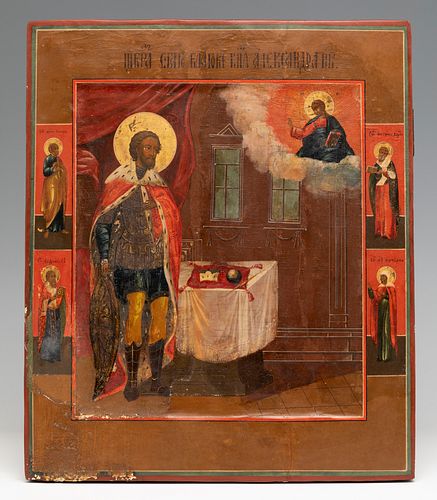Russian school, mid-19th century. "Alexander Nevsky as Monarch". Tempera, gold leaf on board.
Lot 100
About Seller
Setdart Auction House
Carrer Aragó 346
Barcelona
Spain
Setdart Subastas was born in 2004 and is currently the first online art auction in Spain with solidity, prestige and reliability guaranteed by our more than 60,000 users. Setdart has a young, dynamic and enterprising team ready to successfully manage the purchase and sale of art works through custom...Read more
Estimate:
EUR€1,800 - EUR€2,000
$1,935.48 - $2,150.54
Absentee vs Live bid
Two ways to bid:
- Leave a max absentee bid and the platform will bid on your behalf up to your maximum bid during the live auction.
- Bid live during the auction and your bids will be submitted real-time to the auctioneer.
Bid Increments
| Price | Bid Increment |
|---|---|
| EUR€0 | EUR€10 |
| EUR€200 | EUR€25 |
| EUR€500 | EUR€50 |
| EUR€1,000 | EUR€100 |
| EUR€3,000 | EUR€200 |
| EUR€5,000 | EUR€500 |
| EUR€10,000 | EUR€1,000 |
| EUR€20,000 | EUR€2,000 |
| EUR€50,000 | EUR€5,000 |
About Auction
By Setdart Auction House
Nov 3, 2021
Set Reminder
2021-11-03 08:00:00
2021-11-03 08:00:00
America/New_York
Bidsquare
Bidsquare : OLD MASTERS
https://www.bidsquare.com/auctions/setdart-auction-house/old-masters-7786
Setdart Auction House sofia@setdart.com
Setdart Auction House sofia@setdart.com
- Lot Description
Russian school, mid-19th century. "Alexander Nevsky as Monarch". Tempera, gold leaf on board. Measurements: 44,5 x 37 cm. In Orthodox iconography there is a tradition of sanctifying kings. This tradition has Byzantine origin, but it gained great popularity in the territory of Ancient Rus. This typology of saints, in literal translation into English, is called "good believers". This image is dedicated to the figure of Tsar Alexander Nevsky. His first representations appear from the middle of the XVI century, after he was canonized in 1547. At first he was depicted as a monk, since he was ordained a monk just before his death in 1263. However, this typology, although still used, but less frequently, was replaced by his representation as a tsar, due to the growing interest in the genealogy of the Russian monarchy during the second half of the 16th century. In that period, the representation of Russian tsars, even if not canonized, began to be part of different iconographic compositions. In 1724, the iconography of Alexander Nevsky is definitively changed. After his mortal remains had been transferred to the Alexander Nevsky Monastery, built in St. Petersburg, ten years earlier, he came to be represented only dressed as a tsar, with a martial armor and a mantle over his shoulders, leaning against the shield with ensign, and accompanied by the attributes of princely power, as can be seen in the icon of interest. This type was the most widespread during the rule of Russian Emperors Alexander I (1801 - 1826) and Alexander II (1855 - 1881), due to the fact that Alexander Nevsky was their namesake saint. Adding these data to the visual aspect of the icon, it is possible to establish its approximate production date as the middle of the 19th century. The auctioned icon presents an interesting iconography, since it combines the elements of the two canonical representations of Alexander Nevsky. On the one hand, the tsar appears in front of the viewer with the main princely attributes, following the model of the 18th century. On the other hand, he receives the blessing of Jesus Christ, following the prototype of Alexander Nevsky-monk of the 16th century, when he was usually depicted dressed in monastic chiton, receiving the blessing of the Virgin, and, less frequently, of Christ. In the border of the icon are represented different saints, among them are recognized St. Tatiana of Rome, and the apostle St. Peter.
- Shipping Info
-
In-house shipping available. Please inquire at admin@setdart.com.
-
- Buyer's Premium



 EUR
EUR CAD
CAD AUD
AUD GBP
GBP MXN
MXN HKD
HKD CNY
CNY MYR
MYR SEK
SEK SGD
SGD CHF
CHF THB
THB














